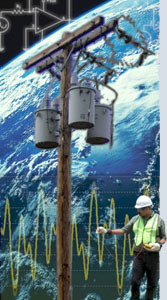Swimming Pool Shocking Due to Poor Perimeter Bonding
Gastonia, North Carolina, USA
Background
The owner of a home was concerned about a shocking sensation that he and his family felt as they used the handrail to get out of their swimming pool. The owner's grandchildren were getting shocked on the sides of the pool, which had a concrete deck. The customer had inquired about this shocking voltage for the past several years.
Possible Causes
The initial investigation considered several possibilities:
- Faulty wiring on the owner's side.
- Open or damaged system neutral/
Action Taken
The possible causes were ruled out by:
- Temporarily de-energizing the owner's wiring by pulling the power meter.
- Inspecting the system neutral because the area of the owner's home was subject to tree-related damage.
The next step in the investigation was to measure the shocking voltage and to check for proper bonding at the swimming pool. The shocking voltage was measured at 7.3 VAC from the pool's water to the handrail. The swimming pool's concrete deck, coping stone, and handrail were not bonded. The owner was informed of the lack of bonding for the deck, coping stone, and handrail.
The next step was to take current readings and neutral-to-earth voltage (NEV) measurements on the circuit. Normally, the decreasing NEV values indicate that the shocking voltage is related to the load. However, the load on the owner's overhead single-phase line was very low. The NEV voltage value was 4.4 VAC on the tap across from the owner's location. This high NEV value indicated that the current was exiting the system.
The results of the measurements are shown in Table 1. The current readings for Section #1 of the circuit indicated that the owner's shocking voltage was a function of current exiting the system due to voltage unbalance on the three-phase line.
 |
| Table 1: Measurements Taken at the Owner's Tap |
Table 2 shows that Section #1 was not balanced. The unbalanced current contributes to the owner's shocking voltage.
 |
| Table 2: Measurements Taken at Three-Phase Line |
Table 3 shows at least 5.9 amps of current flowing on the neutral return path. The neutral return current contributed to the owner's shocking voltage.
 |
| Table 3: Measurements Taken at the Adjacent Open-Wye Circuit |
Solution
The solution to the owner's shocking voltage was to bond the swimming pool's concrete deck, coping stone, and handrail. Also, the load on the three-phase line should be balanced. The adjacent open-wye circuit should be reviewed for additional current balancing.

